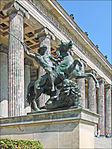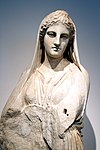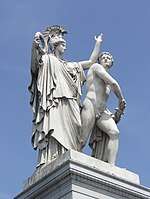Oinochoe by the Shuvalov Painter (Berlin F2414)
5th-century BC Greek artAncient Greek erotic artAntikensammlung BerlinArchaeological discoveries in ItalyIndividual ancient Greek vases

The Oinochoe by the Shuvalov Painter in the Antikensammlung at Berlin (inventory number F 2414) is an erotic depiction from ancient Greek vase painting.
Excerpt from the Wikipedia article Oinochoe by the Shuvalov Painter (Berlin F2414) (License: CC BY-SA 3.0, Authors, Images).Oinochoe by the Shuvalov Painter (Berlin F2414)
Platz der Märzrevolution, Berlin Mitte
Geographical coordinates (GPS) Address Website Nearby Places Show on map
Geographical coordinates (GPS)
| Latitude | Longitude |
|---|---|
| N 52.519 ° | E 13.398 ° |
Address
Museumsinsel
Platz der Märzrevolution
10117 Berlin, Mitte
Germany
Open on Google Maps









